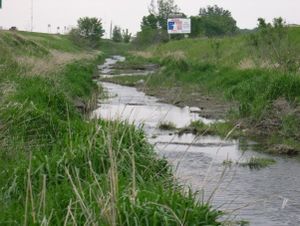
Difference between revisions of "Category:Level 3 - Best management practices/Structural practices/Wet swale"
(Created page with "Category:Level 2 - Best management practices/Structural practices") |
m |
||
| (3 intermediate revisions by the same user not shown) | |||
| Line 1: | Line 1: | ||
| + | [[file:Wet swale.jpg|300px|thumb|alt=photo of wet swale|<font size=3>Photo of a wet swale. Courtesy of Limnotech.</font size>]] | ||
| + | |||
| + | <font size=5>[[Wet swale (wetland channel)|'''Main page for wet swale''']]</font size> | ||
| + | |||
| + | Wet swales occur when the water table is located very close to the surface or water does not readily drain out of the swale. A wet swale acts as a very long and linear shallow <span title="A bioretention practice having an underdrain. All water entering the practice is filtered through engineered media and filtered water is returned to the storm sewer system."> [https://stormwater.pca.state.mn.us/index.php?title=Bioretention '''biofiltration''']</span> or [https://stormwater.pca.state.mn.us/index.php?title=Stormwater_wetlands linear wetland treatment system]. Wet swales do not provide volume reduction and have limited treatment capability. Incorporation of <span title="A check dam is a structure installed perpendicular to flow in a natural or manmade conveyance channel to reduce flow velocity. By slowing flow velocities, check dams can serve multiple functions including reduction of channel scour and erosion, enhancement of sediment trapping, and greater treatment of the water quality control volume via enhanced water detention or retention. Typical check dam materials include rock, earth, wood, and concrete. "> '''check dams'''</span> into the design allows treatment of a portion or all of the <span title="The volume of water that is treated by a BMP."> [https://stormwater.pca.state.mn.us/index.php?title=Water_quality_criteria '''Water Quality Volume''']</span> within a series of cells created by the check dams. Wet swales planted with [https://stormwater.pca.state.mn.us/index.php?title=Plants_for_swales emergent wetland plant species] provide improved pollutant removal. Wet swales may be used as <span title="Pretreatment reduces maintenance and prolongs the lifespan of structural stormwater BMPs by removing trash, debris, organic materials, coarse sediments, and associated pollutants prior to entering structural stormwater BMPs. Implementing pretreatment devices also improves aesthetics by capturing debris in focused or hidden areas. Pretreatment practices include settling devices, screens, and pretreatment vegetated filter strips."> [https://stormwater.pca.state.mn.us/index.php?title=Pretreatment '''pretreatment''']</span> practices. Wet swales are commonly used for drainage areas less than 5 acres in size. | ||
| + | |||
| + | This page provides links to pages that provide information on wet swales. | ||
| + | |||
[[Category:Level 2 - Best management practices/Structural practices]] | [[Category:Level 2 - Best management practices/Structural practices]] | ||
Latest revision as of 14:12, 12 February 2023
Wet swales occur when the water table is located very close to the surface or water does not readily drain out of the swale. A wet swale acts as a very long and linear shallow biofiltration or linear wetland treatment system. Wet swales do not provide volume reduction and have limited treatment capability. Incorporation of check dams into the design allows treatment of a portion or all of the Water Quality Volume within a series of cells created by the check dams. Wet swales planted with emergent wetland plant species provide improved pollutant removal. Wet swales may be used as pretreatment practices. Wet swales are commonly used for drainage areas less than 5 acres in size.
This page provides links to pages that provide information on wet swales.
Subcategories
This category has only the following subcategory.
Pages in category "Level 3 - Best management practices/Structural practices/Wet swale"
The following 27 pages are in this category, out of 27 total.
C
O
R
- References for filtration
- Requirements, recommendations and information for using swale side slope as a BMP in the MIDS calculator
- Requirements, recommendations and information for using swale with an underdrain as a BMP in the MIDS calculator
- Requirements, recommendations and information for using wet swale as a BMP in the MIDS calculator
Media in category "Level 3 - Best management practices/Structural practices/Wet swale"
The following 5 files are in this category, out of 5 total.
- Carpenter Creek detail.pdf ; 5.06 MB
- MIDS WET Swale Sections.dwg ; 743 KB
- VARIOUS CHECK DAMS.dwg ; 382 KB
- Wet and dry swales.dwg ; 378 KB
This page was last edited on 12 February 2023, at 14:12.
